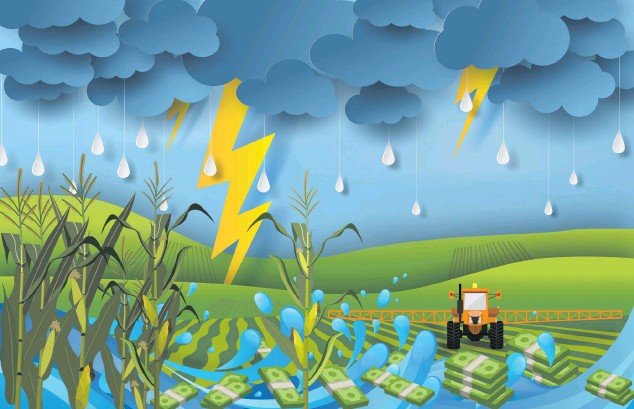FOOD SECURITY
Too much rain means no grain: Farmers and industry watchers look skyward for a sunny reprieve

There can be too much of a good thing. This summer’s rains over much of South Africa, including the key summer crop areas, are a case in point.
On the one hand, dams that just a few years ago were almost running on empty are now filled to the brim, and much of the South African veld is a riot of green that has unfolded under a canopy of clouds. But too much rain makes no grain, and farmers, as well as industry watchers, are now looking skyward for a sunny reprieve.
“We need more sunshine right now; it’s what we need at the moment,” Wandile Sihlobo, chief economist of the Agricultural Business Chamber of South Africa, told DM168.
South Africa’s National Disaster Management Centre has classified the recent severe weather events, which have resulted in a loss of life and damaged property and infrastructure, as a national disaster. To have it “declared” a national disaster will hinge on the assessment of the damage inflicted.
“Impact assessments are already being conducted by provincial disaster management centres and the department of agriculture to determine the extent of damage suffered by producers. In order to have a national disaster declared, these assessments are critical… Reports have been received that some producers have 100% crop losses in some districts and, as we are at the end of the planting season, producers cannot replant. Record high input costs such as fertiliser and fuel are other losses farmers also experienced by the torrential rains,” industry umbrella group Agri SA said in a statement.
Agriculture accounts for only about 2.5% of South Africa’s gross domestic product, but that hardly captures the scale of its importance. The sector is a major employer and source of export earnings, and it has huge potential for growth if the right policies can be cultivated. Food security is also critical to a nation’s wellbeing, and farming is at the centre of politically charged national debates such as those around land ownership and property rights.
So weather patterns matter in South Africa and not just for beachgoers and other outdoor enthusiasts.
This soggy summer is a product of the La Niña weather system, a cooling of the Pacific off the west coast of the Americas, which often heralds wet weather in southern Africa. Its polar opposite, El Niño, occurs when those waters heat up, and the last such event from 2014 to 2016 was responsible for a scorching and record-breaking drought in the region.
This summer season got off to a wettish rather than a drenching start. One commercial maize farmer in North West province told that it was still too dry to plant for much of November and then suddenly it was too wet, delaying much of his planting.
In an update dated 20 December, the South African Weather Service said that, from the September to November period, most of the country received normal to above-normal rainfall. In the first 10 days of December, most of South Africa received above-normal rainfall. A look at the map shows that much of that was concentrated in the maize belt. And in December, 35 of the country’s weather stations with data going back at least a decade set new records for maximum rainfall amounts over a 24-hour period, according to Musa Mkhwanazi, a climatologist with the Weather Service.
“La Niña conditions are expected to continue during the summer season, and the predictions for rainfall over the larger part of the country are for enhanced probabilities of above-normal rainfall during the January-February-March, February-March-April and March-April-May 2022 seasons,” the Weather Service said in December.
Global and South African forecasters see La Niña fading by autumn.
The Weather Service’s next update and longer-range forecast will come out later this month, but in the month since the last update there has been a deluge over swathes of the country, including the key summer crop areas.
“The province most heavily affected is the Free State, and in particular the northwestern Free State, followed by the eastern Free State. But overall … the whole summer rainfall area where grains and oilseeds are planted is experiencing a lot of rain, including KwaZulu-Natal, North West province and Mpumalanga,” Pieter Taljaard, CEO of industry group Grain SA, told DM168.
This raises concerns about the potential impact on plantings and yields, especially for the maize crop, which provides the calorific staple for South Africa’s lower-income households. Last season’s maize crop yielded a bumper harvest of just over 16.2 million tonnes, according to the government’s Crop Estimates Committee (CEC) – 6% bigger than the 15.3 million tonnes reaped in 2020.
In November, the CEC said its initial surveys indicated that grain farmers planned to devote slightly fewer hectares to maize for the 2022 season as they switch to other summer crops such as sunflower seeds and soya beans. The total area they intended to plant for all summer crops was more than 4.34 million hectares – 3.5% higher than what was obtained in 2021.
That scenario has probably been washed out.
“It will likely be less than 4.34 million hectares because of the wet conditions that have delayed plantings,” said Sihlobo. The preliminary estimate for the area devoted to summer grains for 2022 will be released on 27 January and will provide an indication of the impact of the rains.
Less planting than originally anticipated and the impact on yields could signal a smaller maize harvest this season, which could put upward pressure on food prices at a time when inflation is running at a five-year high of 5.9%. There remains potential for flooding, which would also take a bite out of yields and, in the case of subsistence farmers on communal lands, possibly sweep away a season’s crop.
Having said that, time will tell and the national crop overall will hardly be a write-off. Many grain and summer crop farmers, especially in Mpumalanga, which typically plants earlier, are likely to have excellent production.
Anecdotal evidence also suggests yields for the informal cannabis crop have been negatively impacted, with reports of bud rot and powdery mildew. So stoners may find that prices are higher, even if the buzz is not.
For the livestock industry, there are worries that the rains are providing a flourishing environment for the parasites that spread disease among the herds against the backdrop of shortages of vaccines.
A pot of gold at the end of the rainbow
The rains are also in many ways a blessing. At the end of the rainbow lies a pot of gold.
The El Niño-triggered drought is now mostly history. Dam levels across the country, according to Department of Water and Sanitation data – with some exceptions in the Eastern Cape and a few other places – have been filling up nicely. The levels for the Katse Dam in the Lesotho Highlands, which provides water to the industrial heartland of Gauteng, stood at 100.5% on 17 January compared with about 55% this time last year.
The citrus sector – a crucial commodity, as SA is the world’s number two exporter of such fruit – is not complaining. Justin Chadwick, CEO of the Citrus Growers’ Association of Southern Africa, told that the dam levels give “irrigators peace of mind” and that good rains should translate into excellent fruit quality. But he cautioned that pests that impact citrus can also thrive in hot and wet conditions.
The veld in many areas is green and healthy, a far cry from the parched and withered landscape that baked under the searing heat unleashed by El Niño. This is good news for livestock farmers and the game farming industry.
“White rhino are bulk grazers and the veld is in a magnificent condition and the carrying capacity going into winter is excellent. We expect good population growth across the board for all game species,” Pelham Jones, head of the Private Rhino Owners Association, said in an interview. Other sources in the game sector echoed these comments.
For both the game and livestock sectors, this state of affairs will help to reduce costs – at a time when grain prices are relatively high – as less supplemental animal feed will be required because of the quality grazing conditions.
The rains this summer have been a mixed blessing. But it’s better than drought, which is just a curse. DM168
This story first appeared in our weekly Daily Maverick 168 newspaper which is available for R25 at Pick n Pay, Exclusive Books and airport bookstores. For your nearest stockist, please click here.




















 Become an Insider
Become an Insider
Comments - Please login in order to comment.